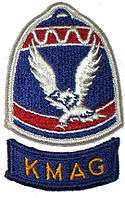Korean Military Advisory Group
| Korean Military Advisory Group | |
|---|---|
|
Shoulder Sleeve Insignia for KMAG | |
| Active | est. 15 August 1948 |
| Country | United States |
| Commanders | |
| Notable commanders |
BG Francis Farrell LTG Gordon Rogers |
| Insignia | |
| KMAG | KMAG Insignia |
The Korean Military Advisory Group (KMAG) (officially United States Military Advisory Group to the Republic of Korea) was a United States military unit of the Korean War. It helped to train and provide logistic support for the Republic of Korea Army.
History
Following the end of World War II, the United States and the Soviet union split up the administration of Korea, with the United States taking charge of the southern half. Beginning in January 1946, the U.S. military government in the south began to form a Korean defense force,[1] and 18 lieutenants from the U.S. Army's 40th Infantry Division were tasked with organizing eight Korea Constabulary Regiments (one for each province,[2]), which were to act as a police force.[3] The Constabulary grew rapidly, from 2,000 men in April 1946[2] to 50,000 in March 1948.[3] When the ROK declared independence on 15 August 1948, the Constabulary was absorbed into the Republic of Korea Army,[2] and the United States created a Provisional Military Advisory Group (PMAG) to continue the work of training and advising the fledgling South Korean military,[4] led by Brigadier General William Lynn Roberts. The 100 American advisors in Korea,[5] working under the auspices of the Department of Internal Security (DIS), were reassigned to PMAG at this time, and the unit's roster was expanded.[6]

On 1 July 1949, PMAG was redesignated the United States Military Advisory Group to the Republic of Korea (KMAG).
When North Korean forces invaded South Korea on 25 June 1950, KMAG became the United States Military Advisory Group, Korea, 8668th Army Unit, under the command of the United States Eighth Army. Brigadier General Francis W. Farrell took command of the unit on 25 July.[4] On 28 December 1950, it was renamed as the 8202nd Army Unit.

Legacy
Dr. Shiela Miyoshi Jager of the Strategic Studies Institute has supported using the highly successful KMAG methods as a model for the Multi-National Security Transition Command - Iraq in its development of the New Iraqi Army.[7]
Notes
- ↑ "ROK Army History". Global Security. Retrieved 3 December 2010.
- 1 2 3 Yuk Gun. "South Korean Army". korean-war.com. Retrieved 3 December 2010.
- 1 2 Summers, pg. 161
- 1 2 Advising Indigenous Forces: American Advisors in Korea, Vietnam, and El Salvador, by Robert D. Ramsey III, Combat Studies Institute Press, Fort Leavenworth, Kansas, 2006, page 21
- ↑ Sawyer, p. 35
- ↑ Stoker, p. 88
- ↑ Dr. Shiela Miyoshi Jager. "Iraq Security Forces and Lessons from Korea" (PDF). Strategic Studies Institute. Retrieved 10 November 2009.
References
- Sawyer, Robert K. (1963). Military Advisors in Korea: KMAG in Peace and War (PDF). U.S. Department of the Army Office of Military History.
- Stoker, Donald J. (2008). Military Advising and Assistance: From Mercenaries to Privatization, 1815-2007. Psychology Press. ISBN 0-415-77015-7. Retrieved 3 December 2010.
- Summers, Harry G. Jr. (1999). Korean War Alamanac. Replica Books. pp. 160–162. ISBN 978-0-7351-0209-5.
